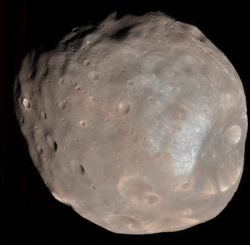This Week’s Finds in Mathematical Physics (Week 264)
Posted by John Baez
In week264 of This Week’s Finds, learn about this doomed Martian moon:

Then learn a wonderful description of the homotopy groups of the 2-sphere in terms of braids, and guess the significance this sequence:
And if you can, help me with theta functions!
Posted at May 19, 2008 1:54 AM UTC

Re: This Week’s Finds in Mathematical Physics (Week 264)
Does Berrick, Cohen, Wong and Wu’s theorem bring us anywhere nearer to demonstrating the Baez-Dolan ‘conjecture’ that somehow or other the homotopy cardinality of the 2-sphere, i.e., the alternating product of its homotopy groups, should equal its Euler characteristic, i.e., 2?